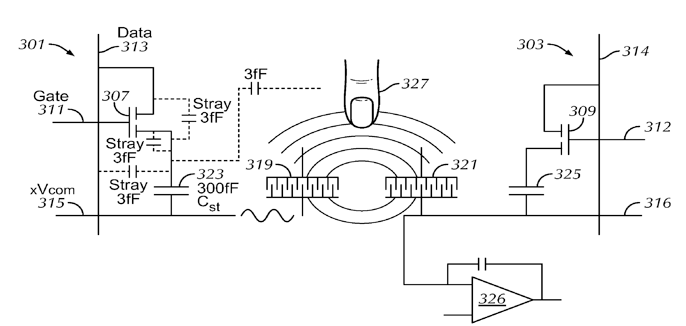A new patent application revealed this week suggests Apple is looking to improve its touchscreen displays with technology that could make them thinner, lighter and brighter.
The application, entitled "Display with Dual-Function Capacity Elements," describes a pair of voltage lines that run across adjacent display pixels. With the described technology, capacitors could be included in the pixels of an LCD display, and could operate individually.
This method would allow panels with integrated touch sensors to be manufactured with fewer parts and processing steps, allowing the display to be thinner, lighter, and brighter. The method would eliminate the need for a touch sensor panel overlaying a display.
"These dual-function capacitive elements form part of the display system that generates an image on the display, and also form part of a touch sensing system that senses touch events on or near the display," the application reads.
"The capacitive elements can be, for example, capacitors in pixels of an LCD display that are configured to operate individually, each as a pixel storage capacitor, or electrode, of a pixel in the display system, and are also configured to operate collectively as elements of the touch sensing system."
Such technology could be employed in a number of Apple's touchscreen devices, including the iPhone, iPod touch, or its rumored tablet device. The patent application was originally filed on Sept. 29, 2008, and the invention is credited to Steve Porter Hotelling, Shih Chang Chang, Lili Huang, and John Z. Zhong.

Another touchscreen-related patent, entitled "Ambient Light Interference Reduction for Optical Input Devices," describes how ambient light can affect an optical touchscreen sensor on an LCD screen. These photosensors are different from a capacity sensor typically used to recognize surface contact.
The problem with photosensors, the application notes, is that they rely upon shadows being cast upon them, which can be falsely triggered due to changing light conditions. Because of this, ambient light can render the technology unreliable.
"Photosensors are not able to readily distinguish between decreases in light associated with a user's specific input and decreases in light occurring from changing environmental conditions," it states.
The application describes technology that could provide an independent light source that would create electromagnetic signals that cover the glass of the display.
"When the user's finger is proximate to a certain region of the touch panel, the electromagnetic signals reflect off of the user's finger and back through the cover glass," the application reads. "One or more photosensors monitoring the presence of these reflected signals service the various regions on the touch panel where input may be detected.
"Thus, when the reflected signals are detected at a certain region, the user's finger may be assumed to be present. In this manner, input to the optical device can be properly detected despite variations in ambient lighting."
The patent application was filed on July 2, 2008. It is credited to Steve Porter Hotelling and Stephen Brian Lynch.


